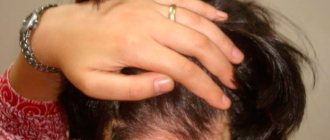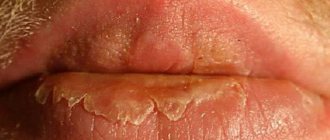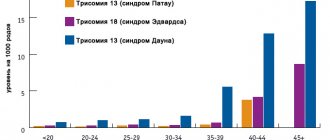Symptoms of different types of erythema infectiosum
The symptomatic manifestation of erythema in most cases is similar to other skin diseases. In order to diagnose a virus, consider a table of its different types and important characteristics:
| Type of disease | Duration | Manifestation on the skin | Symptoms |
| Rosenberg | More than 2 weeks. | The rash appears on the limbs and buttocks, patchy or in the form of nodules. | There is pain in the joints, muscles, head, sleep deteriorates, and an enlargement of the liver and spleen is observed. |
| Chamera | Lasts more than 15 days. | Accompanied by a symmetrical rash on the face in the shape of a butterfly. | The airways become inflamed, conjunctivitis and minor pain in the joints appear. In exceptional cases, the disease may have no symptoms. |
| Nodal | Including relapses, it can last from 21 to 25 days. | Red nodules with induration up to 5 centimeters appear on the skin, and pain occurs when pressure is applied. Fluid accumulates under the skin. The rash is located symmetrically on the front of the lower leg, forearms and thighs. | Hyperthermia and pain in the joints and head occur. |
| Multiform exudative | The average duration is 1 to 6 weeks, and frequent relapses may occur. | The rash manifests itself in different ways: ulcers, blisters, blisters. Located on the body and limbs. In some cases, ulcers and erosions in the anus and genital area may appear. Most often it occurs in the off-season, when the immune system is in a weakened state. | Frequent pain in the head, joints, muscles, hyperthermia and weakness appear. Inflammatory processes develop in the respiratory tract, the liver enlarges and the eyelids swell. |
| Sudden exanthema | Lasts no more than a week. | It appears as a pale pink rash all over the body. | The temperature rises sharply and a headache occurs. |
| Annular centrifugal erythema of Darier | Mostly it becomes chronic and relapses may occur. | On the body and limbs it appears as a red rash, as well as ring-shaped spots with a diameter of 2-3 centimeters. | Headache, hyperthermia and general malaise occur. |
| Toxic | Lasts several days. | The most severe reaction occurs in areas where there was contact with the allergen, but the rash can spread throughout the body. Itching and burning are observed. | Signs of intoxication of the body may appear. |
| Physiological | The duration of the disease is 1-6 weeks. In most cases it disappears within a few days. | The skin turns red and discomfort appears. | Passes without symptoms. |
The infectious form of the disease is transmitted by airborne droplets. If a baby has had erythema, the body produces antibodies, and he will not be able to become infected with it again.
Classification
There is no unified classification of diseases occurring with exanthema. Conventionally, diseases are distinguished in which:
- Rashes are always present ( chicken pox , fever , measles ).
- A rash is not an obligatory symptom, but is noted ( pseudotuberculosis , herpes zoster , enterovirus infection , infectious mononucleosis , typhoid paratyphoid infections ).
- Rashes are possible, but rare (cytomegalovirus and mycoplasma infections).
According to the nature of the spread of the rash:
- Generalized.
- Localized: caused by direct exposure of the virus to the skin; associated with parainfectious process in the skin.
Rashes in infectious diseases are heterogeneous and vary in nature. If we talk about the morphology of the rash, then its primary elements (they appear on intact skin) are divided into:
- cavityless;
- cavitary.
Cavity-free include a spot, papule, nodule, tubercle, and blister. Cavity formations are considered to be a vesicle (vesicle), vesicle and pustule.
The spot has different sizes, it is irregular in shape and does not protrude above the skin. Formed when skin blood vessels dilate. Color varies from pale pink to red. When pressed, it disappears and appears again. If the spot is 1-5 mm in size, small punctate, it is classified as roseola (occurs in scarlet fever , enterovirus and sudden enanthema ). A small-spotted rash measures 5-10 mm (characteristic of rubella, infantile roseola and enteroviral exanthema), a large-spotted rash measures 10-20 mm (occurs with measles), and erythema is a spot larger than 20 mm that merges with others. Hemorrhagic spots ( petechiae ) are found in enterovirus , parvovirus B19 and Epstein–Barr infections.
Papule is a rash that rises above the skin. It is formed with deeper damage to the skin: the involvement of blood vessels and the upper layers of the dermis. Papules can leave a mark in the form of pigmentation and peeling. Papules are often combined with roseola and spots; in such cases, a roseolous-papular rash (up to 5 mm) and maculopapular (up to 20 mm) are described. Papules may be a stage of development of other elements of the rash.
A vesicle (vesicle) is a cavity formation filled with serous or hemorrhagic contents. It develops in the thickness of the epidermis. The contents of the bubble are opened with the formation of a crust (transparent or brown). Vesicles do not leave scars after resolution. This type of rash is characteristic of herpes , chickenpox , and herpes zoster . If leukocytes accumulate in large quantities in the contents of the vesicles, the contents become purulent. Vesicles of pus are called pustules and are characteristic of bacterial infections.
The bubble measures up to 15 mm or more.
Causes
Scientists identified the causative agent of sudden exanthema at the end of the 20th century. It turned out to be herpes virus type 6. This microorganism was first discovered in the blood of examined people who suffered from lymphoproliferative diseases. The herpes virus has its main effect on specific cells of the immune system - T-lymphocytes. This contributes to the fact that significant disturbances in the functioning of the immune system occur.
Currently, scientists have received new results from scientific experiments, which indicate that the virus has several subtypes: A and B. They differ from each other in molecular structure and virulent properties. It has been scientifically proven that sudden viral exanthema in babies is caused by the herpes virus type B. Viruses of subtype A can also have a similar effect, but there are currently no confirmed cases of the disease. After viruses enter the body, processes of a violent immune response are launched, which in some cases proceeds quite violently.
Scientists have identified several reasons that can cause signs of infectious exanthems in a child. These include:
- Bacterial infections. Bacteria cause the appearance of clinical signs of illness in children much less often than viruses. In this case, the most susceptible to the development of infectious exanthema are children who have signs of severe immunodeficiency or children who are often ill.
- Viral infections. They are the most common cause of characteristic rashes on the skin. , flu, childhood quarantine diseases can provoke the appearance of specific signs on the baby’s skin.
- Parasitic diseases. The toxic effect of helminth waste products on the child’s body leads to the child’s disruption of the proper functioning of his own immune system. It must be said that parasites cause disease quite rarely.
- Tendency to express reactions. The presence of an excessive tendency in a child to various things is often a consequence of impaired functioning of the immune system.
- Various immune reactions. These include: immunocomplex, cytotoxic and autoimmune. Such reactions occur when the child has individual hypersensitivity and defects in the functioning of the immune system.
Symptoms
Viral exanthema in children is more often of the macular (spotty) or maculopapular (spot-papular) form. A small rash (fine-spotted, roseolous) occurs with sudden and Boston exanthema. Vesicular with serous exudate - in case of hand-foot-mouth disease. The disease in children under three years of age is milder than in older children and adolescents. There may be variants that manifest only as a rash with fever, but without signs specific to this infection.
Exanthems caused by enteroviruses
These infections are characterized by a general infectious syndrome and, in addition to rashes, a varied clinical picture, including catarrhal syndrome ( pharyngitis ), diarrhea , vomiting, headaches , organ damage (eyes, liver, kidneys) and damage to the nervous system ( meningitis , encephalitis ) in older children . The rash can appear at any stage of the disease, has a characteristic localization only in some infections caused by a certain virus, and is not accompanied by itching.
Enterovirus exanthema can be caused by any type of enterovirus. Most common in children. The rash appears simultaneously on unchanged skin and at different periods of the disease - it can be on the 1-2nd day against a background of high fever or on the 3-4th day of illness after its decrease. Enteroviral diseases are characterized by high fever, often of a two-wave nature.
The simultaneous appearance of the rash is a distinctive feature that distinguishes this infection from measles, which is characterized by the sequence of appearance of the rash: the face and neck, then the torso, thighs and arms, and finally the legs and feet. At this time, the elements on the face become pale.
Enteroviral exanthema is characterized by variability. At the beginning it may be macular (punctate and larger) or maculopapular, and later it may become vesicular or with hemorrhages (hemorrhagic). It is located mainly on the torso, face, and less often on the legs and feet. The spotted elements look like a rash similar to rubella. Maculopapular lesions resemble elements of measles, which merge and form erythematous fields on the body.
A vesicular rash is characteristic of hand-foot-mouth disease. The duration of the rash is short (1-3 days), they disappear without a trace, leaving no skin defects or pigmentation. Rashes on the mucous membrane disappear within the same time frame as on the skin.
The enteroviral group includes the following exanthemas:
- morbilliform;
- Boston (synonymous with epidemic exanthema or roseoloform);
- generalized enteroviral;
- disease of the hands, feet and mouth or foot-and-mouth syndrome (this is a local variant of exanthema).
Diagnosing them without laboratory data is difficult, since they have a similar picture and nature of the rashes, especially with an atypical course.
Measles exanthema
More often observed in young children. The infection begins acutely, with fever, headache and muscle pain. At the same time, redness of the pharynx and sclera appears, there are abdominal pains and vomiting, and loose stools are also possible. From the second day of fever, signs of exanthema immediately appear on unchanged skin. The rash is always located on the face and torso, less often on the arms and legs. Signs of viral exanthema in children with this form are varied: macular, maculopapular, petechial (less commonly). The rash is small, lasts 1-2 days and goes away when the temperature normalizes.
Infectious exanthema (Boston exanthema)
Roseoloform exanthema (Boston disease) also begins acutely with an increase in temperature. In adults, the increase in temperature is more significant than in children. Fever is accompanied by headache, intoxication and prostration. The patient is concerned about a sore and sore throat, and a slight enlargement of the cervical lymph nodes. In some patients, small ulcers are found on the back wall of the throat, as with herpetic sore throat . It is the herpangina elements that make it possible to suspect infection with the ECHO virus. In uncomplicated cases, the fever lasts up to 3 days and for many the disease ends in recovery at this stage. This variant is called Boston fever.
In some patients (approximately 30%), skin rashes occur simultaneously with normalization of temperature. They appear as pinkish-red spots (small spots 0.5-1 cm in size) and are located throughout the body, with a predominant localization on the chest and face, involving the arms and legs. The rash lasts up to 3-5 days and disappears without a trace. The elements of the rash are very similar to the rash of sudden exanthema and the diseases can be confused. A distinctive point is that sudden exanthema occurs only in infants.
Boston exanthema may also be accompanied by petechial rashes. These are small red hemorrhages that do not disappear with pressure. If such rashes occur against the background of symptoms of meningitis , the disease is often mistaken for meningococcal meningitis (it is bacterial in nature, not viral). Typically, infectious exanthema proceeds benignly - without damage to the nervous system. It is observed in children of all ages and adults.
Generalized herpetiformis
This type occurs when the child has an immunodeficiency. It is characterized by the appearance of a small vesicular (vesicles with contents) rash. Unlike rashes during herpetic infection, in this case the vesicles do not group, and their contents do not become cloudy.
Disease of the hands, feet and mouth (foot and mouth syndrome) or viral pemphigus.
One of the variants of local enteroviral exanthema, which is characteristic of the infection, is caused by the ECHO 9.16 and Coxsackie A viruses. The characteristic localization of the rash (extremities and mouth) allows the diagnosis to be made clinically without serological and PCR studies. The infection most often occurs in children under 9-10 years of age, but can also occur in adults.
A characteristic feature, however, like all enteroviral infections, is that the prevalence is greater in the summer and autumn. Patients are dangerous in terms of infection 2-3 days from the moment of illness.
Patients experience febrile or high fever, moderate intoxication syndrome and respiratory symptoms, and sometimes abdominal pain. A day later, enanthema appears on the mucous membrane - earlier than the rash on the skin. It has the character of vesicles, which quickly open with the formation of aphthae (ulcerations), and a “favorite” localization: lips, cheeks, tongue, soft palate and arches. This sign greatly simplifies diagnosis. Rashes are single or multiple, but even the presence of single rashes in the mouth in combination with exanthema on the feet and hands makes it possible to make a correct diagnosis. The oropharynx is not affected by enanthema, and this fact distinguishes this disease from herpangina .
The severity of damage to the mucous membrane varies, so it may not bother the patient much or may lead to refusal to eat. The second stage appears a small vesicular rash (up to 5 mm), not itchy, on the palms, fingers and soles. Sometimes it affects the lateral surfaces of the hands and feet, buttocks, and genitals. The rashes on the limbs are always symmetrical.
In other areas there may be rashes, but rarely with single elements of a different nature - roseolous or roseolous-papular. Elements of the rash on the skin do not suppurate and disappear without crusts - this distinguishes this infection from chickenpox. It is characteristic that vesicles and papules are simultaneously found on the body. The elements disappear without a trace in 4-7 days.
Thus, the main criteria for the diagnosis of this disease are:
- fever;
- vesicles and papules on the skin of the palms and soles;
- skin rashes are painless;
- symmetry of lesions on the palms and soles;
- no itching;
- aphthous enanthema on the oral mucosa.
The disease is mild and resolves on its own without complications within a week or 10 days. But those who have recovered shed the virus for up to 6 weeks. There is an abortive variant of the infection - roseolous-papular rashes on the skin do not progress to the vesicular stage, and there are no aphthae in the mouth.
Exanthema in adults
Of all the variants of enterovirus infection, Boston exanthema . Viral exanthema in adults caused by herpevirus type 6 very rarely occurs with a characteristic clinical picture and rash. Most often, this infection occurs in the form of chronic fatigue syndrome . This is due to the fact that 95% of adults have antibodies to herpes virus type 6.
Preventive actions
Prevention of exanthema is not necessary, because It occurs once, after which immunity is developed, and the baby subsequently does not suffer from this disease. General recommendations are to improve the health and hardening of the baby to strengthen the immune system, which will allow him to resist various infections and viruses, and if an illness occurs, to recover quickly.
You should also protect your child from communicating with peers if they have been diagnosed with exanthema. Breastfed children tolerate roseola much more easily. Parents need to be vigilant towards their child, and if they suspect exanthema, immediately seek help from a doctor.
Treatment
Viral exanthema in children does not require special treatment. The rashes disappear on their own when the body copes with the infection. Do not cover the rash with brilliant green or other similar means until a doctor sees it.
If a baby has measles or rubella, treatment usually involves bed rest, antipyretics and antihistamines. Chickenpox is usually easily tolerated by children and there is usually no need to resort to strict bed rest.
Often during this disease, rashes are lubricated with brilliant green or a solution of manganese, although, according to many pediatricians, this does not make much sense. Treatment of herpetic infections involves the administration of Acyclovir in ointments.
Exanthema can also be treated using folk remedies with warm baths with decoctions of medicinal herbs (chamomile, string, calendula, celandine). You can add a few drops of fir oil to a bath with herbal infusions.
A sick child can be given tea brewed from dried raspberries, blueberries, rose hips, black currants, and bird cherry. They also add lemon balm, raspberry and currant leaves. During illness, it is better for the child not to be in the sun, so as not to aggravate the manifestations of the rash.
▼We RECOMMEND YOU TO STUDY▼
Treatment of exanthema includes mandatory bed rest and taking the following groups of medications:
- antipyretics - Efferalgan, Nurofen, Paracetamol, Maxicold, Ibuklin, Panadol;
- antiseptics - brilliantine green, methylene blue;
- vitamins with a high content of vitamin D or Aquadetrim;
- antihistamines - Zodak, Suprastin, Zirtec, Cetrin;
- antiherpes drugs - Acyclovir, Pencivir, Zovirax, Fenistil, Panavir.
If you have exanthema, you should not take antibiotics, since such treatment will not have any effect on the viral nature of the disease. Antimicrobial drugs can be prescribed by a doctor only if bacterial microflora is present.
Viral exanthemas go away on their own; it only takes time for the rash to completely disappear. You can treat only the accompanying symptoms: reduce high fever, drink a lot, ease nasal breathing and sore throat.
Bacterial exanthemas require antibiotic treatment. For meningococcal infection, it should be prescribed immediately after the baby has been examined by a doctor. Treatment of meningococcal infection should be carried out only in a hospital setting; the child may have to stay in intensive care for some time.
In scarlet fever, an antibiotic is needed to prevent serious complications on the kidneys, joints, and heart.
Allergic exanthemas are treated by prescribing a special diet and antihistamines. Topical creams and ointments can be used to reduce itching. It is imperative to identify the cause of the allergic reaction.
Treatment of urticaria
Pharmaceutical drugs used to treat urticaria should be taken as recommended by your doctor. The best treatment for this condition is to know and avoid trigger factors. The hives will probably go away on their own. But at the same time, medical supervision is a prerequisite to exclude the development of complications.
Treatment for urticaria in children includes:
- taking antihistamines to reduce the rash;
- eliminating foods that cause hives;
- prescribing diuretics to eliminate severe edema;
- using antipruritic ointments to relieve the condition.
- in some situations, hormones are used (topically and by injection).
You need to keep a diary about what the child does and eats. This approach allows us to identify predisposing factors and eliminate them.
Gradually, one can narrow down the real causes and respond accordingly.
With such a complication as Quincke's edema, coughing attacks appear and breathing becomes difficult. In this case, urticaria in children requires emergency care.
Young children often experience swelling of the gastrointestinal mucosa, which is accompanied by vomiting. In severe cases, damage to the nervous system and brain occurs. Such conditions are dangerous to health and life, so delaying a visit to the doctor is unacceptable.
Most children switched to a hypoallergenic diet recover quickly and recover even without medication.
Diagnosis of viral exanthema in children
- General blood analysis. The study reveals a decrease in the number of leukocytes in the blood and an increase in the number of lymphocytes among them (relative lymphocytosis). This is a non-specific analysis; This blood picture is characteristic of an acute viral infection. It does not help determine the species of the pathogen.
- Serological reactions. Such studies are aimed at identifying immunoglobulins in the blood that are specific to a particular disease. The presence of class M immunoglobulin in the blood indicates an acute viral disease.
- Some diseases require highly specialized research methods, for example, with Kawasaki disease, the diagnosis is confirmed by the detection of coronary artery aneurysms using coronary angiography.
For a number of diseases, diagnosis is based on the characteristics of the clinical picture of the disease. This, for example, happens in the typical course of herpes zoster, when external manifestations combined with local pain are so characteristic that laboratory tests are not required.
Viral exanthema in children, the symptoms of which are similar to the symptoms of allergies, requires differential diagnosis with rashes of an allergic nature. The key diagnostic feature that allows differentiating viral exanthema from other types of rashes is its localization on the surfaces of the soles and palms.
Parvovirus infection requires differentiation from acute urticaria. The differential diagnostic feature in this case is the weak effectiveness of antihistamines for parvovirus exanthema, or its complete absence.
Differential diagnosis of exanthema provoked by the rubella virus will be facilitated by a specific symptom of this disease - enlargement of the occipital lymph nodes.
List of sources
- Bystryakova L.V. Infectious exanthemas in children. L.: Medicine. 1982. 216 s
- Zubik T.M., Ivanov K.S., Kazantsev A.P. Differential diagnosis of infectious diseases. Guide for doctors. - L.: Medicine, 1991. - 336 p.
- Anokhin V.A., Sabitova A.M., Kravchenko I.E., Martynova T.M. Enterovirus infections: modern features // Practical medicine. Pediatrics. — No. 9 (85). - 2014. - pp. 52-59. 7.
- Peter G. Heger: Pediatric dermatology. Differential diagnosis and treatment in children and adolescents. 2013; 410-427.
- Drozdov V.N., Novikov A.I., Obert A.S., Belan Yu.B. Exanthematous infections in children. Lectures for intern doctors. - M.: Medical book, 2005. - 217 p.
Therapeutic measures
There is no specific treatment regimen for exanthema; the elements of the rash disappear on their own when the body copes with the infection on its own. It is forbidden to apply brilliant green and other antiseptic solutions to the affected areas until the child has been examined by a doctor.
If a child is diagnosed with measles or rubella, he needs bed rest, as well as the use of antipyretic drugs based on paracetamol. To prevent the addition of a bacterial infection in the presence of itching, antiallergic medications are prescribed:
- Zodak,
- Zyrtec,
- Suprastin.
In any case, drink plenty of fluids, as this will help remove toxic substances from the body.
For topical application it is recommended to use the following ointments:
- Fenistil,
- Elokom,
- La Cree.
Applying these ointments for five days will help clear up the rash.
Chickenpox is easily tolerated in the vast majority of cases; it is recommended to lubricate the elements of the rash with brilliant green or a solution of potassium permanganate.
Herpes infections are treated with an ointment called Acyclovir. In more severe cases, antiviral agents are prescribed, such as Arbidol, Anaferon.
Exanthema of enteroviral origin requires the administration of glucocorticoids for oral administration.
Breastfed babies are recommended to be put to the breast as often as possible. This need is explained by the fact that mother’s breast milk contains a large amount of antibodies that help fight the disease.
If the affected areas of the skin are dry, they can be lubricated with baby cream.
The room where the sick child is located must have cool, humidified air, otherwise the baby will sweat, which will complicate the course of the disease. Therefore, you need to ventilate the room and carry out wet cleaning as often as possible.
You can eliminate the rash using recipes from folk sources, but such treatment must be agreed with a doctor. The use of baths prepared on the basis of decoctions of medicinal plants, such as:
- chamomile,
- series,
- calendula,
- celandine.
It is recommended to add a few drops of fir oil to the bath water.
Fresh potato juice can be applied to the affected areas of the skin three times a day. To prepare it, you need to grate the potatoes on a fine grater and squeeze.
Positive dynamics are observed if you give your child teas prepared on the basis of:
- dry raspberries,
- blueberries,
- rosehip,
- black currant,
- bird cherry.
You can also use lemon balm, currant and raspberry leaves. During the treatment period, it is better for the child to avoid exposure to the open sun, as this can increase the intensity of the appearance of the rash.
Which doctor treats exanthema?
If a skin rash appears, accompanied by fever and headache, you should consult a dermatologist or infectious disease specialist. If your local clinic does not have such specialists, it is recommended to visit a GP or make an appointment with a general practitioner. A small child should be shown to a pediatrician or pediatric infectious disease specialist. If a baby has a severe fever, diarrhea, severe anxiety, or crying, you need to call an ambulance or invite a doctor from a children's clinic to your home.
Diet
Diet 15 table
- Efficacy: therapeutic effect after 2 weeks
- Timing: constantly
- Cost of food: 1600-1800 rubles per week
This group of diseases does not require a special diet and Diet 15 table . In case of diarrhea, which sometimes accompanies an infection, patients are prescribed a gentle diet: pureed soups, boiled porridges, steamed omelettes, chopped boiled meat. It is necessary to pay attention to the patient's compliance with the drinking regime (1.5-2 liters depending on age). Drinking plenty of fluids reduces intoxication syndrome, helps lower the temperature and facilitates the course of the disease.
Diagnostics
When diagnosing exanthema, differentiation comes first. A viral rash must be distinguished from other skin lesions. To do this, a thorough physical examination of the patient is performed in daylight or a bright lamp.
During the examination, the dermatologist pays attention to the nature and size of the elements, their location and tendency to merge
To confirm exanthema, the following diagnostic measures are carried out:
- RNA test;
- general blood analysis;
- ECG;
- Ultrasound;
- X-ray.
If a viral infection of the spinal cord or brain is suspected, the patient is prescribed a puncture of the cerebrospinal fluid.
Tests and diagnostics
Diagnosis is complex and includes epidemiological history data, taking into account the symptoms of the disease and laboratory confirmation. To establish a diagnosis, information about contacts with infectious patients in any group and at home is important. In this case, the duration of the incubation period is taken into account, the dynamics of the appearance of the rash and its changes during the course of the disease are determined.
An objective examination takes into account the characteristics of the rash:
- shape of elements;
- quantity (abundant, sparse, single);
- localization;
- color and tendency to merge;
- appearance dates and order;
- evolution (dynamics);
- presence or absence of itching;
- outcome of the rash (disappearance without a trace, crusts, scars, peeling).
Some infections (for example, roseola infantum , measles , rubella , hand-foot-mouth disease ) do not cause diagnostic difficulties and the diagnosis is established on the basis of typical clinical manifestations. However, it is better to carry out specific diagnostics. Taking into account age criteria, children under 1 year of age should first of all be examined for HHV6 infection, and children over 3 years of age for parvovirus infection. Enterovirus infections occur in children of all age groups.
For diagnostics the following are used:
- Virological method of isolating a virus from biological materials and cultivating it in cell culture. The method requires more time to make a diagnosis.
- The ELISA method determines specific antibodies IgM, IgA, IgG to the HHV-6 virus or enteroviruses. Early markers include IgM titer. IgG appears later. The study of paired sera over time and a 4-fold increase in antibody titer confirm the diagnosis. The first blood test is taken no earlier than 5 days of illness. Reinfection is indicated by the detection in the early stages of the disease of not only specific IgM antibodies, but also IgG antibodies.
- The use of PCR, which detects the virus in tissues (blood, feces, saliva, nasopharyngeal washes, vesicular discharge). Sample collection is carried out under sterile conditions in the first 3 days of illness. Detection of DNA or RNA viruses (depending on the identity of the viruses) by PCR is a more sensitive method for diagnosing a primary infection. Reverse transcriptase PCR reliably differentiates any latent viral infection.
- General clinical blood tests. With roseola in infants, leukopenia , neutropenia and thrombocytopenia , the number of lymphocytes increases, and atypical mononuclear cells may appear. For many viral diseases, a lymphocytic reaction is inherent, but the most distinct one is with mononucleosis , rubella , and measles .
Treatment of exanthema
How to treat exanthema? First of all, it is necessary to identify the pathogen and deal with it. The fight against skin elements in this case is symptomatic.
Treatment of exanthema includes mandatory bed rest and taking the following groups of medications:
- antipyretics - Efferalgan, Nurofen, Paracetamol, Maxicold, Ibuklin, Panadol;
- antiseptics - brilliantine green, methylene blue;
- vitamins with a high content of vitamin D or Aquadetrim;
- antihistamines - Zodak, Suprastin, Zirtec, Cetrin;
- antiherpes drugs - Acyclovir, Pencivir, Zovirax, Fenistil, Panavir.
If you have exanthema, you should not take antibiotics, since such treatment will not have any effect on the viral nature of the disease. Antimicrobial drugs can be prescribed by a doctor only if bacterial microflora is present.
Prevention
Specific prevention of exanthema has not yet been developed. As preventive measures, doctors recommend maintaining personal hygiene, strengthening the immune system, eating properly and nutritiously, and avoiding sick people with fever and skin rashes. Such measures significantly reduce the risk of developing illness.
In most cases, the outcome of exanthema is favorable. The disease ends with complete recovery and the acquisition of permanent immunity. There is no vaccination against skin lesions, so prevention and isolation of the patient comes first.
What it is?
An acute reaction of a child's body in response to various infections with the appearance of a rubella-like rash on the skin is called exanthema. The prevalence of this childhood disease throughout the world is quite high. Infectious exanthema can occur in both boys and girls. Doctors register quite a lot of cases of the disease in newborns and infants.
Most often in pediatric practice, sudden exanthema occurs. Its incidence peaks between 2 and 10 months of age.
Such an acute reaction of the child’s body is due to a strong immune response to the penetration of an infectious pathogen into it.
Older children and adolescents suffer from this disease much less frequently. In adults, infectious exanthemas practically do not occur. Such a high incidence in children is associated with the special functioning of their immune system. The immunity of some babies reacts to various infections quite violently and vividly, which is accompanied by the appearance of specific symptoms of the disease on the skin.
Years ago, doctors used the term “six-day sickness.” That's what they called sudden exanthema. The essence of this definition is that the clinical symptoms of the disease completely disappear in the sick child on the sixth day. This name is not currently used. In some countries, doctors use different terminology. They call sudden exanthema infantile roseola, pseudorubella, 3-day fever, roseola infantum.
There is also another, quite common form of the disease called Boston exanthema. This is an acute pathological condition that occurs in babies as a result of ECHO infection. During the course of the disease, the child develops a macular-like rash, high fever, and severe symptoms of intoxication syndrome. Scientists have already identified the causative agents of the disease. These include some subspecies of ECHO viruses (4,9,5,12,18,16) and less commonly Coxsackie viruses (A-16, A-9, B-3).
With Boston exanthema, pathogens enter the baby's body through airborne droplets or through the nutritional route (along with food). Cases of Boston exanthema in newborns have been described. In this case, the infection occurred in utero.
General information
Exanthema (rash) is a reaction of the skin and mucous membranes (in this case we speak of enanthema) to the action of microbes or viruses.
It has different shapes, sizes and accompanies many diseases. Currently, infectious exanthemas (or another name - viral exanthemas) are combined into a group of viral infections, which at a certain stage manifest themselves as a rash. The infectious nature is supported by an acute onset, intoxication, temperature, the cyclical nature of the process, and the presence of characteristic signs for a particular infectious disease.
The difficulty is that for correct diagnosis, and therefore treatment, it is important to know the differential signs of exanthema that distinguish one disease from another. If measles, rubella, infectious mononucleosis, chickenpox are accompanied by exanthema as an obligatory component of the clinical picture of this disease, then with other viral infections the rash is unstable and changeable. Therefore, these infections often remain unrecognized, and the appearance of a rash is regarded as a manifestation of urticaria , atopic dermatitis or an allergic reaction to medications.
Viral exanthema on the body indicates the systemic spread of the pathogen. An important sign is that the viral rash is rarely localized to the palms and plantar surfaces (with the exception of some infections). Exanthema often coexists with enanthema (rash on the mucous membrane), with the latter appearing 1-2 days earlier. Some signs of viral replication in the mucous membranes of the mouth help in making a diagnosis. With herpangina (an infection caused by the Coxsackie A virus), ulcers appear on the mucous membrane of the tonsil arches and uvula, with measles - Koplik-Filatov spots, and petechiae on the palate with infectious mononucleosis. Even with careful examination, about 50% of infectious exanthems remain unspecified.
Causes of viral exanthema in children
The cause of exanthema is swelling of collagen fibers as a result of a violent reaction of the immune system to the penetration of the virus into the body.
The prevailing type of morphological elements of the rash depends on which layer of the skin contains the largest number of infectious agents. And this, in turn, depends on the type of virus.
The etiology of viral exanthema is quite diverse. It is believed that skin rashes occur due to the influence of the following pathogenic mechanisms on the body:
- The tissue is affected by viruses that spread along the bloodstream. This means that the disease is accompanied by enteroviruses, herpes type 1, and so on.
- A skin rash with viral exanthema appears due to pathological reactions between immune cells and the infectious agent. It is according to this principle that exanthema appears with rubella.
The causes of viral exanthema in adults and children, as a rule, are the following:
- The appearance of measles, rubella or herpes type six, which causes roseola.
- The presence of Epstein-Barr virus, cytomegalovirus or enteroviruses.
- The emergence of herpes virus type seven. In this case, doctors usually diagnose sudden exanthema.
- The emergence of herpes virus type 1. In this case, this disease accompanies shingles or chickenpox.
- The presence of Coxsackie virus when viral pemphigus occurs.
- Presence of adenoviruses. In this case, a visculous rash appears on the skin.
- Allergic exanthema may occur under the influence of allergens.
Pathogenesis
The following pathogenetic mechanisms are distinguished in the development of viral exanthema:
- Various viruses enter the skin through the bloodstream and cause tissue damage.
- Activation of the body's immune defense factors.
- Interaction of pathogens with immune factors (humoral and cellular) and the production of pro-inflammatory cytokines . This mechanism causes the rash to appear.
- Viremia stimulates the formation of neutralizing antibodies (IgM), which ultimately leads to its cessation.
The basis for the appearance of any rash is inflammation. The virus has an initial effect on the blood vessels of the skin, the damage of which is manifested by hyperemia . Then an inflammatory reaction develops around the vessels in the form of erythema . More pronounced inflammation is manifested by various exudative rashes. In some cases, circulating immune factors themselves, without the presence of pathogens, can cause rashes ( purpura fulminans , acute urticaria , Stephen Jones syndrome ).
Epidemiology
Viral infections with exanthema are caused by various viruses and some of them are precisely defined:
- The sixth disease is associated with herpes viruses types 6 and 7. It manifests itself as roseola in children, and in adults as chronic fatigue syndrome, which is associated with the persistence of the virus. It occurs in children under 3 years of age, with a peak incidence from 7 to 13 months. Most children are seropositive at birth (that is, they have maternal antibodies), but their titer decreases by 5 months. Type 6 HHV is characterized by the ability to persist and remain in the infected person’s body in a latent state without manifestation of the disease. Some scientists associate multiple sclerosis , pityriasis rosea , and thrombocytopenic purpura , but such statements are controversial.
- measles virus causes the corresponding disease.
- Parvovirus B19 - Chamer's erythema or burning cheeks disease. Itching with this disease is moderate.
- Boston exanthema is an infection caused by the ECHO 9.16 virus, less commonly by Coxsackie virus. For the first time in 1951 in Boston during an epidemic, the causative agent of this infection was described and studied.
- Coxsackieviruses A and B and ECHO are associated with hand-foot-mouth disease.
- Other enteroviral exanthemas are associated with infection with Coxsackie viruses A10, A16 and enterovirus type 71.
The source of infection is the patient and the virus carrier (for enterovirus infection). The patient sheds the measles virus during the last 2 days of the incubation period until the 4th day of the rash. Individuals who have not been vaccinated and have not had measles are highly susceptible to the virus and can become ill during their lifetime at any age. The same applies to enterovirus infections, which are caused by different serotypes of viruses, then immunity is developed only to a given serotype of the virus (type-specific). This means that the next time a person may become ill with an enterovirus infection caused by another type of virus currently circulating in nature. A person who has been ill sheds the virus in their stool for several weeks.
Virus infection occurs in various ways:
- Airborne. Characteristic of the sixth disease, measles, rubella. In the sixth disease, the virus infects the salivary glands and is released along with saliva. The gateway to infection in the case of airborne transmission is the mucous membrane of the respiratory tract. In the mucosal epithelium, the virus multiplies, spreads hematogenously and becomes fixed in organs. From the last days of incubation and the first days of the appearance of the rash, the virus is released from the blood, so transmission of infection (including the sixth disease) is possible through blood obtained from the patient during this period.
- Fecal-oral - more typical for enteroviruses that cause Boston exanthema, hand-foot-mouth disease. Enteroviruses are ubiquitous and remain in the environment for a long time (water, soil, household items, food) because they are resistant to chemical and thermal factors. They penetrate the mucous membrane of the gastrointestinal tract, multiply in the lymph nodes, and after 2-3 days they enter the blood ( viremia ) - this is the period that is accompanied by the appearance of a rash. For these infections, an airborne transmission mechanism cannot be ruled out.
- The incubation time for infections is different: for enterovirus infections it is 3–8 days, for measles it is slightly longer – 6–21 days, for rubella – 16–20 days. All infections are characterized by an acute onset, fever , sore throat, muscle pain and diarrhea (for some diseases).
Fifth disease
This was previously the name given to erythema infectiosum of Rosenberg and Chamer. The causative agent is the DNA virus B19 from the parvovirus family. Children develop very recognizable swelling and redness on their cheeks, as if from spanking.
The body is covered with reddish patterns, similar to lace. The latent phase of the disease lasts up to fourteen days. Sometimes, a couple of days before the rash, the temperature rises slightly, there is a headache, weakness, the urge to vomit, and the mucous membrane of the respiratory tract becomes inflamed.
First, the rash covers the face in spots. Soon they unite into solid red areas on the surface of the cheeks.
After four days, the face clears up, but the neck, torso and folds of the arms and legs are strewn with spots with rounded edges and nodules of different shades of red. The rash is lighter in the center, so it looks like a lace mesh.
Sometimes it sprinkles on my palms and feet too. The skin itches. With manifestations on the epidermis, the patient’s infectiousness disappears. The rash goes away in about ten days, leaving no traces. The influence of ultraviolet radiation, hot water, low temperatures, overexertion and anxiety can delay recovery.
Joint problems occur as a complication in those who have recovered from parvovirus erythema. This is swelling, pain, inflammation of symmetrically located joints of the arms and legs. Treatment is primarily aimed at alleviating and eliminating symptoms.
Symptoms of urticaria
Hives appear as red spots, swelling and blisters. The main symptoms are itching and burning sensation on the skin. Symptoms may progress and spread to other areas of the body.
Additional symptoms of urticaria in children include:
- nausea and vomiting;
- increased body temperature;
- discomfort in the joints.
The spots can be as small as a dot or the size of a coin. Typically, spots appear and disappear within a few hours. However, chronic hives can last for more than 6 weeks.










